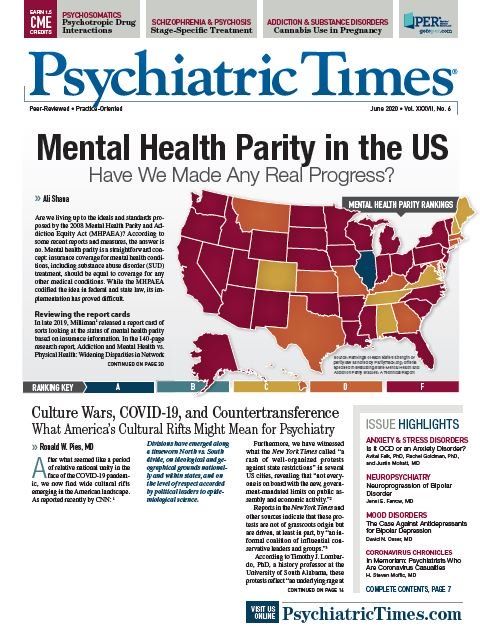Publication
Article
Psychiatric Times
Neuroprogression of Bipolar Disorder in Children and Adolescents
Author(s):
Critical brain maturation occurs from fetal development through adolescence; given the complex and variable nature of these changes, disentangling abnormal neurodevelopment from neuroprogression is a formidable task.
vegefox.com/AdobeStock

NEUROPSYCHIATRY
Bipolar disorder, typically a chronic and recurring illness associated with significant disability, has a total worldwide prevalence estimate of 2.4% across the spectrum of the disorder.1 The notion that bipolar disorder could be progressive dates back to Kraeplin (1913), who observed that “...the disease shows the tendency later on to run its course more quickly and to shorten the intervals...”2 Indeed, evidence suggests an association between multiple episodes and cycle acceleration, treatment resistance, functional impairment, higher rates of comorbidity and suicide risk, increased number of hospitalizations, and cognitive impairment.3
Neurobiological mechanisms may underlie this progression. Recurrent mood episodes, potentially including exacerbating factors such as psychosocial stressors and substance abuse, for instance, may lead to pathological brain changes mediated by processes such as oxidative stress, inflammation, and alterations to neurotrophins. These brain changes, in turn, could predispose individuals to poorer medication response and a progressively deteriorating clinical course.4
The concept of neuroprogression remains controversial. Evidence of progressive brain changes occurring over the bipolar clinical continuum is inconsistent and lacking in supportive longitudinal data (Table).
Neuroprogression and structural neuroimaging
A family history of bipolar disorder is the most significant risk factor for developing the disorder, with an estimated heritability of 59% to 85%.5 Evaluation of the children of parents with bipolar disorder—who are at-risk individuals—provides an important resource to examine neurobiological abnormalities associated with genetic risk; it also informs an understanding of the relationship between neurobiological changes and early psychopathology as well as the neurobiological antecedents to a mood episode.
Mapping clinical progression with associated brain changes is fundamental to supporting the concept of neuroprogression. This process is complicated by confounding variables, including the use of psychotropics (which may confer positive or negative neurotrophic effects) and comorbid substance or alcohol use, as well as by the challenge of differentiating between abnormal brain development versus a progressive process. Critical brain maturation, involving myelination and synaptic pruning, occurs from fetal development through adolescence; given the complex and variable nature of these changes, disentangling abnormal neurodevelopment from neuroprogression is a formidable task.6
Replicated findings of abnormal gray matter volumes in the right ventrolateral prefrontal cortex of at-risk individuals are noteworthy, as this region is involved with emotion and attention regulation—important areas of impairment in bipolar disorder. Abnormal gray matter findings in at-risk youth highlight the challenge of evaluating neuroprogression. Insofar as they are largely based on cross-sectional studies, they may represent stand-alone genetic risk markers, early manifestations of the disease process, neuroprotective compensatory changes, or genetic markers that interact with neurodevelopment to materialize later in the illness. In all, it is important to conduct prospective longitudinal studies to provide insight into these findings.6,7
White matter studies in at-risk youth are more consistent and demonstrate abnormalities of the cingulum, corpus callosum, and the prefrontal areas as well as of the tracts connecting the frontal, temporal, and parietal lobes. In addition, longitudinal evidence suggests that baseline reduced white matter integrity in at-risk individuals remains stable over time. Collectively, these findings suggest that premorbid white matter abnormalities in childhood may be representative of genetic risk rather than a neuroprogressive process.6,7
Clinical progression and treatment considerations
Children of parents with bipolar disorder have a higher risk for anxiety, depression, and behavioral disorders and up to 75% have at least one childhood axis I disorder. By young adulthood, other psychiatric disorders precede bipolar development in 20% of cases while 55% develop other psychiatric illnesses.8
Evidence of clinical antecedents to bipolar disorder informs clinical staging models of bipolar disorder development. One such model proposes a clinical continuum that evolves from identification of a well at-risk child, to childhood nonspecific sleep and/or anxiety disturbances or disorders, followed by a pubertal single depressive episode and/or minor mood episodes (adjustment and subaffective mood disorders), then mid- to late-adolescent recurrent major depression, and, ultimately, an index hypomanic or manic episode in early adulthood. In advancing early detection and intervention, a clinical staging model may afford the opportunity to mitigate a progressive clinical trajectory via well-timed treatment intervention.9
While there are data to inform the pharmacologic management of pediatric bipolar disorder, there is little empirical evidence to guide the clinical management of symptomatic at-risk youth. The use of lithium, the first medication approved by the FDA for pediatric bipolar disorder, was initially informed by adult data, with studies evaluating its pediatric use endeavoring to bridge this gap, such as the Collaborative Lithium Trials. In terms of acute monotherapy for manic and mixed states, the available evidence for the mood-stabilizing benefits of anticonvulsants is weaker in the pediatric population. Second-generation antipsychotics are more effective than lithium and anticonvulsants but are associated with more adverse effects, including weight gain and metabolic disturbances.10
Currently, divalproex, carbamazepine, and lamotrigine are not FDA-approved for bipolar management in youth, while lithium is approved for acute manic and mixed states in youths aged 12 to 17 years. Risperidone, quetiapine, aripiprazole, and asenapine are FDA-approved for acute manic and mixed states in youths aged 10 to 17 years and olanzapine for acute manic and mixed states in adolescents aged 13 to 17 years. Lurasidone and combination olanzapine/fluoxetine are FDA approved for depression associated with bipolar I disorder in youths aged 10 to 17 years. There are no FDA-approved medications for individuals at risk for bipolar disorder.
At-risk youth may be at increased risk for antidepressant-induced mania or hypomania as well as other treatment-emergent adverse effects. Furthermore, psychostimulant exposure in at-risk youths raises concern for stimulant-induced mania, hypomania and/or mood dysregulation; however, some evidence suggests it does not contribute to the development of bipolar disorder, even in a high-risk population. Additionally, extant evidence indicates that stimulant and/or antidepressant exposure may or may not be associated with an earlier age of bipolar onset.11
There are limited randomized, placebo-controlled, double-blind studies evaluating the treatment of at-risk youth, and extant pharmacological studies are inconsistent. Divalproex may or may not alleviate mood symptoms.12,13 Lithium did not demonstrate efficacy in alleviating depression.14 Treatment with paroxetine or with a combination of paroxetine and divalproex was associated with the development of a manic episode and/or hypomanic symptoms or suicidality in more than 50% of a small sample of depressed high-risk youth.15 Quetiapine significantly improved mood symptoms in high-risk youth; however, an increased body mass index was noted over the 12-week period.16
A 12-week double-blind, placebo-controlled study evaluated at-risk youth with cyclothymic disorder or bipolar disorder not otherwise specified. Compared with placebo, aripiprazole was significantly more efficacious in reducing manic symptoms; however, longer-term studies are needed to determine effectiveness and tolerability beyond the acute treatment phase.17
Overall, there are limited pharmacotherapy studies to inform treatment of the at-risk population and further research is needed to determine safe and effective treatments. Increasingly, findings suggest the viability of nonpharmacologic treatment options. In symptomatic high-risk youth, family focused therapy may confer more rapid recovery from baseline mood, as well as more weeks in remission and fewer manic/hypomanic symptoms.18 Mindfulness-based cognitive therapy may improve clinical severity in anxious high-risk youth.19 Interpersonal and social rhythm therapy, which confers mood stability via promotion of good sleep hygiene and regularization of daily rhythms, may be associated with decreased risk for subthreshold symptoms of mania/hypomania in at-risk youth.8
In addition to psychosocial interventions, omega-3 fatty acids may be beneficial. Indeed, considering their neurotrophic, anti-inflammatory, and neuroprotective properties, deficiency of eicosapentaenoic acid (EPA) and docosahexaenoic acid (DHA) may be a risk factor for recurrent mood disorders.20 Moreover, graded erythrocyte EPA and DHA deficits are associated with an increasing risk for bipolar disorder in at-risk youths.21 Interestingly, there is evidence that omega-3 fatty acid monotherapy is safe, well-tolerated, and modestly improves manic symptoms in youths with bipolar disorder;22 additionally, combination omega-3-fatty acids plus inositol reduces manic and depressive symptoms.22 Overall, with limited efficacy of traditional mood stabilizers and potential significant adverse effects associated with atypical antipsychotics, omega-3 fatty acids and/or psychosocial interventions may be attractive early-intervention options for at-risk youths.
Neuroprogression and treatment considerations
When considering evidence that successive episodes could confer treatment resistance, neuroprogression-informed medical decision-making suggests adopting an assertive treatment approach in youth to prevent or mitigate the onset of mood episodes. Indeed, adult studies have found that experiencing more affective episodes confers a poorer antimanic lithium response as well as a poorer olanzapine response for acute mania and maintenance.23,24 The presence of more episodes worsens response to group psychoeducation, while adjunctive cognitive behavioral therapy is more effective in individuals who have experienced fewer than 12 episodes.25,26 However, to lend support for neuroprogression and, effectively, for early intervention, prospective longitudinal studies that demonstrate decreasing response to a given treatment over successive episodes are needed.
The possibility of neuroprogression also suggests consideration of the neuroprotective potential of psychotropics in treating bipolar or at-risk youth. Evidence indicates that lithium protects against excitotoxic apoptosis; that lithium and valproate reduce oxidative stress; and that lithium, valproate, and second-generation antipsychotics increase brain-derived neurotrophic factor.4 Furthermore, past lithium or divalproex exposure may be associated with greater amygdalar gray matter volume in youths with bipolar, and long-term lithium exposure may protect against hippocampal atrophy in bipolar adults.27,28 However, these cross-sectional designs limit the attribution of neuroprotective processes to mitigation of a progressive bipolar course.
A prospective 8-week study of adults with bipolar who were treated with lithium monotherapy demonstrated clinical improvement concurrent with a normalizing effect on mania-related functional brain connectivity.29 In a 12-week study of at-risk youth, divalproex monotherapy was not associated with structural, neurometabolite, or functional brain changes.30 Overall, to draw more definitive conclusions about the role of neuroprotection in implementing treatment strategies for bipolar or at-risk youth, it is important to examine at-risk through illness states via longitudinal prospective studies that contemporaneously evaluate neuroimaging and clinical and treatment course.
Controversy and ethical considerations
The concept of neuroprogression is controversial. In counterpoint to cross-sectional evidence of cognitive deterioration with successive episodes, longitudinal evidence suggests that cognitive deficits are stable throughout the continuum of the disorder. Moreover, some long-term studies demonstrate an increase in cycle duration over time or random affective cycling patterns rather than cycle acceleration, the latter a tenet of the neuroprogression hypothesis. Indications of more functional impairment with successive episodes do not consider patients with recalcitrant symptoms after a first episode who may be at higher risk of recurrence. Indeed, this suggests that the relationship between recurrence and functional outcome is preexistent at disorder onset.
Likewise, evidence indicates the existence of bipolar subgroups and the possibility that the same subgroup of about one-third of patients demonstrates cognitive deterioration, more episode recurrences, treatment resistance, and/or poorer functional outcomes. If this is the case, it may be distinct and different pathophysiological pathways between subgroups that account for neurobiological changes and differences in clinical outcome.
Importantly, the concepts of clinical staging and neuroprogression raise ethical considerations. Identification of youth at risk for bipolar disorder introduces vulnerability to stigmatization and may induce psychological distress in erroneously implying that bipolar disorder development is inevitable. The idea that early treatment and psychotropic-associated neuroprotection prevent progression to later bipolar stages could lead to unnecessary treatment with psychotropics associated with significant adverse effects.31
Concluding thoughts
Neuroprogression is a concept that is not wholly supported. In children and adolescents, a clinical progression is evident in the evolution from asymptomatic at-risk status to subthreshold symptoms to the first threshold mood episode. However, evidence of accompanying progressive neurobiological changes associated with bipolar disorder after its onset is insufficient. It is important to conduct longitudinal, prospective clinical studies to evaluate neurobiological indices of neuroprogression. Future longitudinal studies have the potential to inform clinical staging models that improve our understanding of the bipolar clinical continuum and the potential role of early intervention in delaying or preventing bipolar disorder in at-risk youth.
Dr Farrow is Adjunct Assistant Professor, Department of Psychiatry and Behavioral Neurosciences, University of Cincinnati College of Medicine, Cincinnati, OH. She reports no conflicts of interest concerning the subject matter of this article.
References
1. Merikangas KR, Jin R, He J, et al. Prevalence and correlates of bipolar spectrum disorder in the world mental health survey initiative. Arch Gen Psychiatry. 2011;68:241-251.
2. Kraeplin E. Manic-Depressive Insanity and Paranoia (1913). Edinburgh: E and S Livingstone; 1921.
3. da Costa SC, Passos IC, Lowri C, et al. Refractory bipolar disorder and neuroprogression. Prog Neuropsychopharmacol Biol Psychiatry. 2016;70:103-110.
4. Berk M. Neuroprogression: pathways to progressive brain changes in bipolar disorder. Int J Neuropsychopharmacol. 2009;12:441-445.
5. Wiggins JL, Brotman MA, Adleman NE, et al. Neural markers in pediatric bipolar disorder and familial risk for bipolar disorder. J Am Acad Child Adolesc Psychiatry. 2017;56:67-78.
6. Romo-Nava F, Farrow JE, Patino LR, et al. Neuroprogression in children and adolescents with bipolar disorder. In: Kapczinski F, Magalhães PVS, Berk M, Eds. Neuroprogression in Psychiatry. Oxford, UK: Oxford University Press; 2019: 175-189.
7. Nery FG, DelBello MP. Neuroimaging findings in youth at risk for bipolar disorder. In: Soares JC, Walss-Bass C, Brambilla P, Eds. Bipolar Disorder Vulnerability: Perspectives from Pediatric and High-Risk Populations. London: Elsevier; 2018: 115-138.
8. Goldstein TR, Merranko J, Krantz M, et al. Early intervention for adolescents at-risk for bipolar disorder: a pilot randomized trial of interpersonal and social rhythm therapy (IPSRT). J Affect Disord. 2018;235:348-356.
9. Duffy A, Jones S, Goodday S, Bentall R. Candidate risk indicators for bipolar disorder: early intervention opportunities in high-risk youth. Int J Neuropsychopharmacol. 2015;19:pii: pyv071.
10. Stepanova E, Findling RL. Psychopharmacology of bipolar disorders in children and adolescents. Pediatr Clin North Am. 2017;64:1209-1222.
11. Goldsmith M, Singh M, Chang K. Antidepressant and psychostimulants in pediatric populations: is there an associating with mania? Paediatr Drugs. 2011;13:225-243.
12. Chang KD, Dienes K, Blasey C, et al. Divalproex monotherapy in the treatment of bipolar offspring with mood and behavioral disorders and at least mild affective symptoms. J Clin Psychiatry. 2003;64:936-942.
13. Findling RL, Frazier TW, Youngstrom EA, et al. Double-blind, placebo-controlled trial of divalproex monotherapy in the treatment of symptomatic youth at high risk for developing bipolar disorder. J Clin Psychiatry. 2007;68:781-788.
14. Geller B, Cooper TB, Zimerman B, et al. Lithium for prepubertal depressed children with family history predictors of future bipolarity: a double-blind, placebo-controlled study. J Affect Disord. 1998;51:165-175.
15. Findling RL, Lingler J, Rowles BM, et al. A pilot pharmacotherapy trial for depressed youths at high genetic risk for bipolarity. J Child Adolesc Psychopharmacol. 2008;18:615-621.
16. DelBello MP, Adler CM, Whitsel RM, et al. A 12-week single-blind trial of quetiapine for the treatment of mood symptoms in adolescents at high risk for developing bipolar I disorder. J Clin Psychiatry. 2007;68:789-795.
17. Findling RL, Youngstrom EA, Rowles BM, et al. A double-blind and placebo-controlled trial of aripiprazole in symptomatic youths at genetic high risk for bipolar disorder. J Child Adolesc Psychopharmacol. 2017;27:864-874.
18. Miklowitz DJ, Schneck CD, Singh MK, et al. Early intervention for symptomatic youth at risk for bipolar disorder: a randomized trial of family-focused therapy. J Am Acad Child Adolesc Psychiatry. 2013;52:121-131.
19. Cotton S, Kraemer KM, Sears RW, et al. Mindfulness-based cognitive therapy for children and adolescents with anxiety disorders at-risk for bipolar disorder: a psychoeducation waitlist-controlled pilot trial. Early Interv Psychiatry. 2019;14:211-219.
20. McNamara RK, Nandagopal JJ, Strakowski SM, DelBello MP. Preventative strategies for early-onset bipolar disorder. Towards a clinical staging model. CNS Drugs. 2010;24:983-996.
21. McNamara RK, Jandacek R, Tso P, et al. Adolescents with or at ultra-high risk for bipolar disorder exhibit erythrocyte docosahexaenoic acid and eicosapentaenoic acid deficits: a candidate prodromal risk biomarker. Early Interv Psychiatry. 2016;10;203-211.
22. Wozniak J, Faraone SV, Chan J, et al. A randomized clinical trial of high eicosapentaenoic acid omega-3 fatty acids and inositol as monotherapy and in combination in the treatment of pediatric bipolar spectrum disorders: a pilot study. J Clin Psychiatry. 2015;76:1548-1555.
23. Swann AC, Bowden CL, Calabrese JR, et al. Differential effect of number of previous episodes of affective disorder on response to lithium or divalproex in acute mania. Am J Psychiatry. 1999;156:1264-1266.
24. Berk M, Brnabic A, Dodd S, et al. Does stage of illness impact treatment response in bipolar disorder? Empirical treatment data and their implication for the staging model and early intervention. Bipolar Disord. 2011;13:87-98.
25. Colom F, Reinares M, Pacchiarotti I, et al. Has number of previous episodes any effect on response to group psychoeducation in bipolar patients? A 5-year follow-up post hoc analysis. Acta Neuropsychiatrica. 2010;22:50-53.
26. Scott J, Payket E, Morriss R, et al. Cognitive-behavioural therapy for severe and recurrent bipolar disorders: radomised controlled trial. Br J Psychiatry. 2006;188:313-320.
27. Chang K, Karchemskiy A, Barnea-Goraly N, et al. Reduced amygdalar gray matter volume in familial pediatric bipolar disorder. J Am Acad Child Adolesc Psychiatry. 2005;44:565-573.
28. Simonetti A, Sani G, Dacquino C, et al. Hippocampal subfield volumes in short-and long-term lithium-treated patients with bipolar I disorder. Bipolar Disord. 2016;18:352-362.
29. Spielberg JM, Matyi MA, Karne H, Anand A. Lithium monotherapy associated longitudinal effects on resting state brain networks in clinical treatment of bipolar disorder. Bipolar Disord. 2019;21:361-371.
30. Chang K, Karchemskiy A, Kelley R, et al. Effect of divalproex on brain morphometry, chemistry, and functioning in youth at high-risk for bipolar disorder: a pilot study. J Child Adolesc Psychopharmacol. 2009;19: 51-59.
31. Martino DJ, Samamé C, Marengo E, et al. A critical overview of the clinical evidence supporting the concept of neuroprogression in bipolar disorder. Psychiatric Res. 2016;235:1-6.❒








